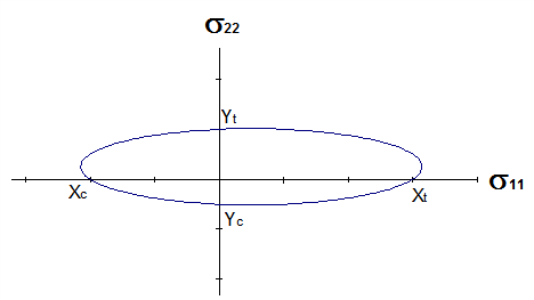
| AID | Analysis Name |
|---|---|
| 135 | Max Strain 1 Direction |
| 136 | Max Strain 2 Direction |
| 137 | Max Strain 12 Direction |
| 138 | Max Stress 1 Direction |
| 139 | Max Stress 2 Direction |
| 140 | Max Stress 12 Direction |
| 141 | Tsai-Hill Interaction |
| 142 | Tsai-Wu Interaction |
| 143 | Tsai-Hahn Interaction |
| 144 | Hoffman Interaction |
| 145 | Hashin Matrix Cracking |
| 146 | Hashin Fiber Failure |
| 147 | LaRC03 Matrix Cracking |
| 148 | LaRC03 Fiber Failure |
| 149 | Tsai-Wu Strain |
| 150 | Tsai-Wu Strain, Effective Shear Allowable |
| 151 | Open Hole Tension (OHT) |
| 152 | Open Hole Compression (OHC) |
| 154 | Puck 2D, Inter-Fiber Fracture (IFF) |
| 155 | Puck 2D, Fiber Fracture (FF) |
| 156 | Puck 3D, Inter-Fiber Fracture (IFF) |
| 157 | Puck 3D, Fiber Fracture (FF) |
| 203 | Interlaminar Shear |
Ply-based failure analysis is the traditional approach to composite analysis where failure of a laminate is determined whenever any ply reaches its material strength limit.
Ply-based failures include fundamental failure theories such as:
Below is typical failure envelope in terms of ply stress for these failure theories.

Quadratic failure theories are also included such as:
Below is an example quadratic failure theory (Tsai-Hahn) that predicts failure when the left hand side interaction terms are greater than 1.

where






A failure envelope for this failure method is shown below.

Finally, physics based theories are included, such as
Physics based failure theories are ones where the theories take into account different modes of failure in response to different loading conditions. For example, in the LaRC03 failure criterion, five different failure criterion are modeled including: 1) Matrix Failure, Compression; 2) Matrix Failure, Tension; 3) Fiber Failure, Tension; 4) Fiber Failure, Compression; and 5) Matrix Failure, Biaxial Compression.
All ply-based failure theories are based on "anchor points" from purely uniaxial tests (pure load in the fiber direction, pure load in the transverse direction, etc.) to determine the allowables for each ply. Based on these values, the failure of a ply under mixed modes is determined from these anchor points combined with a failure theory.
For all failure theories, test data can be incorporated as in-situ correction factors that take into account the percentage of fibers in each direction, thickness, temperature, etc.
See the HME document for more information.
